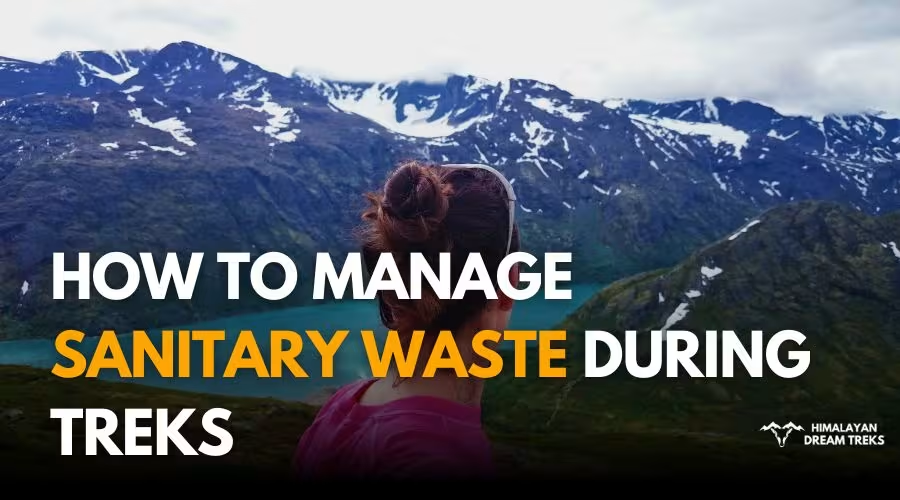Trekking is perhaps the most lovely way to interact with nature. Walking in dense green forests, gliding across rivers, and ascending mountains is like a fantasy. But when we dive deep into nature, we have to safeguard it as well. One of the essential aspects of being responsible while trekking is properly handling the waste material, particularly sanitary waste.
Most of the new trekkers are shy about this matter, but it is of great importance that we discuss it. Without proper handling of sanitary waste, it can kill animals, contaminate water bodies, and ruin the mountains’ beauty. This guide will show you how to manage sanitary waste during treks easily and safely. Let’s get in and discover everything about it!

Table of Contents
Why Sanitary Waste Management during a Trek Matters a Lot for Nature and Health
It’s not only about unhygienic, sanitary waste left in nature is unsafe for all living things. Here’s why:
Water and Land Pollution: Pads, tampons, and wet wipes are not biodegradable. When you discard them on the ground or rivers, they remain there for decades and pollute the soil. They also contaminate drinking water sources.
Damage to Animals: Wild animals such as foxes, dogs, or bears are interested in strong odors. They can sniff and consume used sanitary waste, and this makes them extremely ill. It can lead to infections or even death.
Transmission of Diseases: Opened sanitary waste can contain germs. Other trekkers or villagers can get infected if they touch it unintentionally.
Loss of Natural Beauty: Part of the reason we go trekking is to experience the unspoiled and pristine beauty of nature. If trash is around, it ruins the whole experience of trekking for everyone.
Respect for Nature: Disposing of your trash demonstrates respect. It shows that you are a responsible visitor. Everybody should care for wildlife, nature, locals, and fellow visitors.
That’s why, before going on any hike, everybody should be completely prepared to dispose of sanitary waste in the proper manner.
How to Properly Plan and Pack for Sanitary Waste Disposal during a Trek

Proper planning makes waste disposal simple. Before going for your trek, make sure that you pack the following:
- Ziplock Bags: Do not forget to pack at least 5–10 medium-sized ziplock bags. They are waterproof and seal out bad odor.
- Big Dark Waste Bag: Carry a bigger, dark-colored bag (like a black plastic bag or a thick cloth bag) to keep all your small ziplock bags inside safely.
- Disposable Gloves: Carry 2–3 pairs of disposable gloves for hygiene while handling waste.
- Tissue Papers: Carry a full packet of tissues to wrap used items and clean your accessories to prevent germs.
- Hand Sanitiser: Extremely important to have clean hands after the change.
- Menstrual Products: Stock sufficient sanitary pads, tampons, or menstrual cups based on your flow and length of the trip.
- Spare Underwear and Soap Sheets: Keep a spare set of underwear and small soap sheets to wash if leakage or accident happens.
You will feel more self-assured and less tense about the trek once you have packed accordingly.
Tips on Dealing with Sanitary Waste Hygienically while Trekking
As you approach changing your sanitary items amid the trek, take note of the easy-to-follow tips:
Step 1: Seek out a secluded Place
Leave the path. Find a place at least 200 meters from water sources such as rivers or lakes.
Step 2: Transition Quickly and Hygienically
Put on your gloves if required. Discard the soiled pad or tampon. Fold it tidily in tissue paper.
Step 3: Contain the Waste
Place the wrapped pad or tampon in a ziplock bag. Seal the bag firmly to trap odor.
Step 4: Store in Black Bag
Keep all the sealed ziplock bags within your large dark bag. This will make your backpack odourless and clean.
Step 5: Hand Sanitiser
Always wash your hands thoroughly with sanitizer after touching waste.
Step 6: Bring Waste to the End of Trek
Never bury, burn, or discard waste along the trail. Bring it back to town and dump it in a proper dustbin once the trek is over.
Taking care of the waste maintains your health, maintains nature’s cleanliness, and maintains fun trekking for all.
Why You Should Never Bury, Burn, or Dispose of Sanitary Waste in Nature
Some trekkers believe that it is acceptable to burn or bury their sanitary waste. It is not. Here’s why:
- Burial won’t work: Animals dig it up, and it remains in the soil for decades. Pads and tampons take 500–800 years to break down!
- Incineration is Hazardous: Sanitary pads contain plastic coats. Burning sends out poisonous fumes, causing damage to nature and your well-being.
- Dumping is Extremely Destructive: Dumping waste makes rivers, woods, and trekking trails polluted. Other fellow trekkers and villagers also suffer due to this.
The only and best right thing to do is to take your waste back safely.
Group Trekking: How to Manage Sanitary Waste in a Group
If you are trekking in a group, observe these rules:
Keep Your Waste Private:
Each person has his/her waste bag. Be considerate of others’ privacy.
Help Each Other If Needed:
If a person is shy or needs assistance with waste, help him/her with kindness.
Inform Trek Leaders:
Certain trekking companies have special waste disposal methods. Let your trek leader know at the beginning about your sanitary requirements.
Carry Shared Waste Bags:
Some groups bring additional bags for emergency waste collection.
Supporting and helping one another makes group trekking enjoyable and safe.
What to Do After the Trek Ends
After your trek is over and you arrive at the town or city:
Find a Proper Dustbin:
Locate a dustbin for non-biodegradable waste (plastic waste). Dispose of your sealed waste bags here.
Never Leave Waste in Trekking Area:
Even if you feel exhausted, carry your trash along with you until you reach a good disposal area.
Wash Your Hands and Wash Your Bags:
Once you have discarded trash, wash your hands thoroughly. Clean your trash-collecting bags to eliminate all germs.
By doing all these small things, you finish your duty towards nature.
Eco-Friendly Sanitary Products: A Smarter Trekker’s Choice
If you also want to make your trekking experience even more eco-friendly, the use of sustainable menstruation products is a smarter choice. Conventional sanitary pads and tampons are not biodegradable, which, when discarded in nature, remain long-term environmental pollutants.
An ideal instance of this sort of product includes a menstrual cup, whereby you can use for several years and thus accomplish quite well at eliminating wastage as well as all the quantity that you may end up needing to carry about with you. That could truly save your life, making it rather easier on yourself, to make the trek more of an enjoyable event. You should wash the cup thoroughly after use, especially if on extended walks in backwoods areas where facilities may not be easily accessible. You can just wash it with soap and water once you arrive at your camp or lodge.
Cloth pads can even be used again if you want to use something more natural. These can be hand-washed and reused and, unlike disposables, contribute nothing to the litter that ruins our beautiful trekking landscape. You save not only on litter deposited in nature but on body weight and discomfort during treks by using green sanitary products.
Dealing with Emergencies: What to Do If You Lose Your Supplies
Even with the best planning, on a trek things may not go as planned and one can be left short or without sanitary products. If this is the case, it is always wise to remain calm and think. You may also attempt to call other trekkers or your trekking guide and inquire if they have spares. It is always better to be with people who can take care of one another in the event of an emergency. Nevertheless, it is also better to carry a mini first-aid kit and some spare sanitary products. This way, you will never be caught off guard to face unexpected emergencies.
If still not able to find the supplies, clean cotton cloth can be used as an alternative material until original ones are procured. Ensure it is hygienic and change it often. The most important thing to keep in mind here is not to allow poor hygiene, even in such a case, because poor hygiene can lead to infections, and your trek will be unpleasant.
Other than carrying additional supplies with you, it is also advisable to have the positions of villages or shops along your trekking route where you can buy sanitary products in case you need them. It is always better to be safe than sorry and risk your health.
We, as trekkers, need to be proactive and ready to respond to any unexpected events. By making sure you have the necessary things for emergencies, you can take care of your health and well-being during your trek without bothering about the supply of sanitary items.
Some Extra Tips from Experienced Trekkers
Here are some practical tips provided by individuals who trek regularly:
Label Your Waste Bag:
Use a sticker or ribbon to mark your waste bag clearly so you don’t mix it with your food bag by mistake.
Carry Small Soap Pieces:
Instead of big soap bars, carry tiny soap sheets. They are light and perfect for small cleanups.
Practice Mental Rehearsal:
Before your trek, mentally practice how you will change, wrap, seal, and store your waste. This builds confidence.
Talk to Local Guides:
Local guides may be aware of secret dustbins or disposal sites in tiny villages. Use their assistance if necessary.
Motivate Others:
If someone is littering, politely inform them about bringing waste back. A small cue will make a significant change.
Use Breathable Bags:
Rather than completely airtight plastic bags, use reusable, breathable, waterproof bags for taking waste to prevent unpleasant odors.
Adhering to these suggestions will simplify your trekking trip and render it much greener.
Conclusion
Trekking teaches us to appreciate nature’s beauty, yet at the same time to conserve it. Proper disposal of sanitary waste during treks is a minor effort with maximum gain.
Plan, always dispose of your litter, and get rid of it. Never burn, bury, or flush down tampons, pads, or tissues outdoors. Be respectful to the rivers, mountains, and animals that inhabit them and to the forests too.
As a responsible trekker, you are a true nature hero. By taking little care and planning, you can enjoy your trekking without leaving any negative mark.
Read More Articles on Similar Topics

Leave a Comment